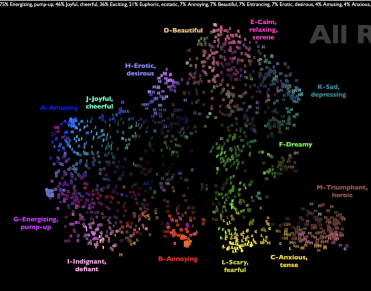
Tarentino's method is to show bloody massacres against a backdrop of happy music. This allows us not to be attached to the victims, and to experience the unfolding of violence without empathy (Pulp fiction, Django unchained...). Neuroscientists (Shenzen University in China Oct/2017) have shown that simply listening to happy music prevents our brains from reacting to the sight of someone in pain. People were invited to listen to happy music and shown photographs of someone accidentally slashing their hand with a kitchen knife. Using electrodes to record the electrical currents produced by their brains, they observed a decrease in the waves associated with empathy. On the contrary, participants who had listened to sad music showed an intense brain response to the sight of the person cutting their hand. The discrepancy between the emotions we feel and those experienced by the sufferer leads to emotional incongruity.
https://news.berkeley.edu/2019/02/04/audio-map-of-exclamations
Scientists at UC Berkeley have studied the emotional responses of more than 2,500 people living in the USA and China to thousands of different types of music, including rock, folk, jazz, classical and metal. They set up an interactive audio map from which users can listen to different music and see if their emotions match those identified in the study.
Berkeley News (Jan/20): "Ooh là là! Musik evokes at least 13 emotions. Scientists have mapped them".

